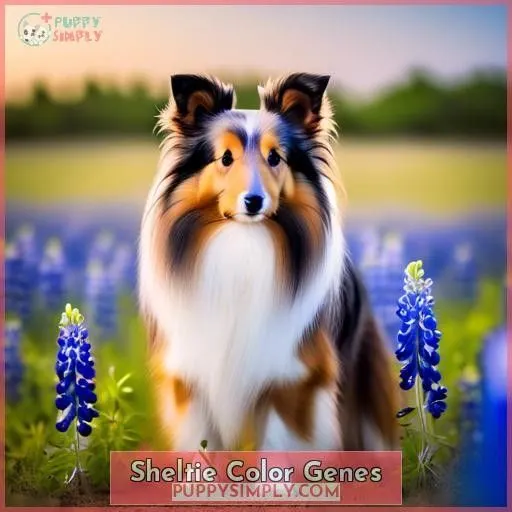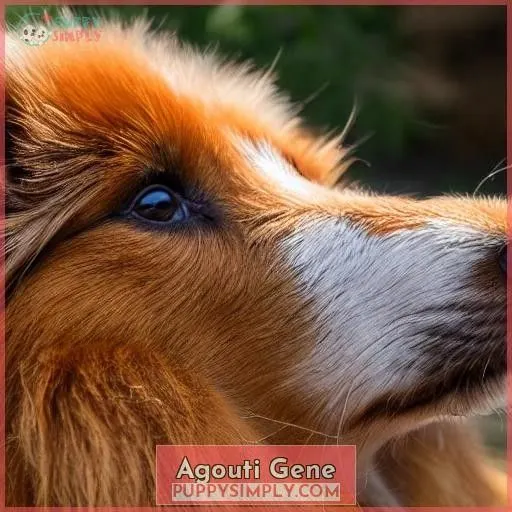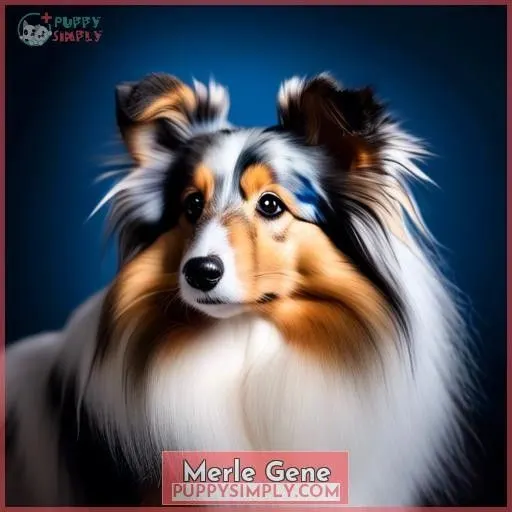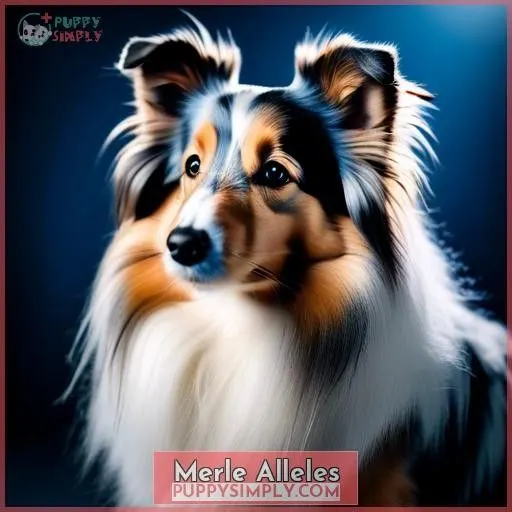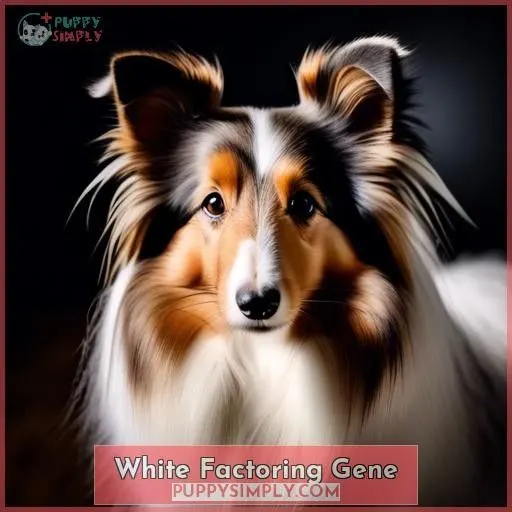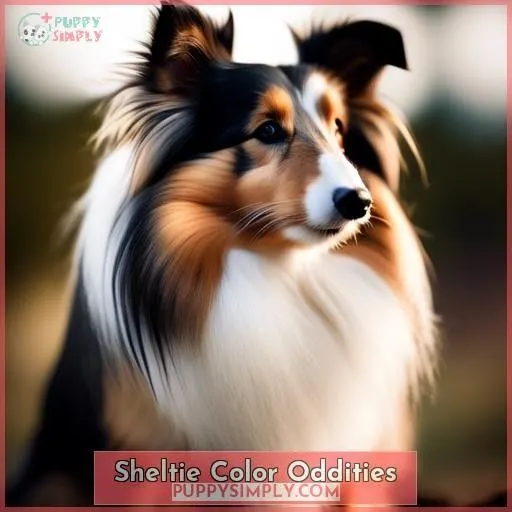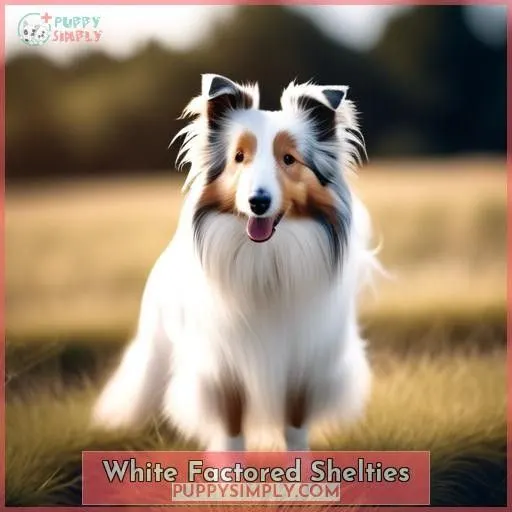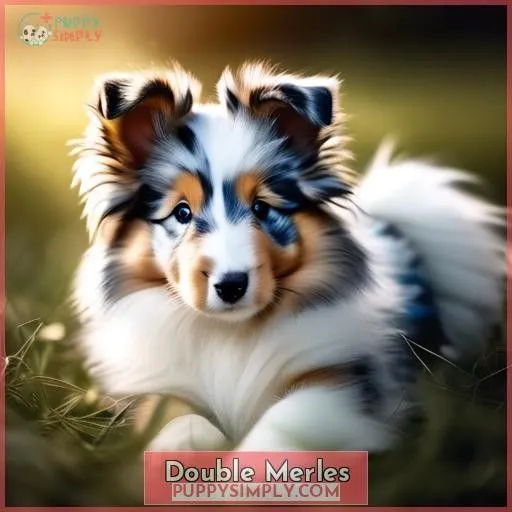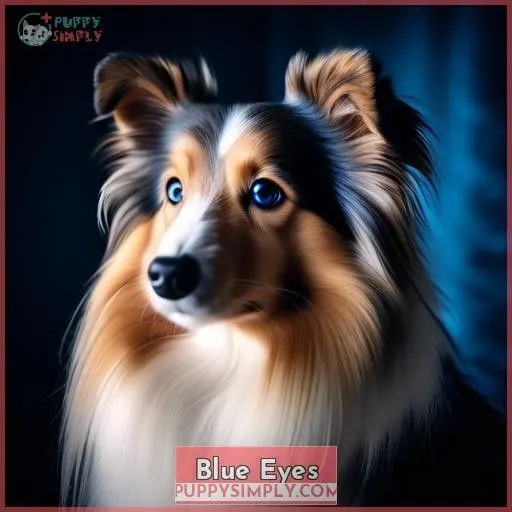This site is supported by our readers. We may earn a commission, at no cost to you, if you purchase through links.

Yes, Shelties can change colors throughout their lifetimes. Their coat colors are controlled by various genetic factors, including the agouti and merle genes, which interact to create a diverse array of hues.
As the Sheltie matures, the interplay of these genes can cause their coat to shift from golden to mahogany sable, or from a classic merle pattern to a more pronounced harlequin look.
Understanding the underlying genetics provides insights into a Sheltie’s appearance and even their overall well-being. If you’d like to explore deeper into the fascinating world of Sheltie color genetics, read on.
Table Of Contents
Key Takeaways
- Shelties can change colors throughout their lifetimes due to genetic factors like the agouti and merle genes.
- The agouti gene is responsible for the banding and ticking patterns in a Sheltie’s coat, while the merle gene dilutes black fur to blue and gray.
- Understanding Sheltie color genetics can provide insights into their appearance and overall well-being.
- Breeding strategies must consider the white factored gene to avoid health implications associated with excessive white markings.
Do Shelties Change Colors Shetland Sheepdogs?
Yes, Shelties can change colors as they grow, especially in terms of their coat’s intensity and pattern. Pure Sable Shelties are born with gray fur that darkens to gold or tan as they mature. Mahogany Sable Shelties can develop much darker fur that may become chestnut or mahogany over time.
Tri Color Shelties, which have a combination of black, white, and tan, can have varying amounts of tan coloring that may appear around the face, ears, legs, and under the tail.
Blue Merle Shelties have a dilute gene that changes their main color from mostly black to light blue or gray, and their coat may have irregular patches of black, white, and tan.
The color changes are influenced by the genetic variations passed down from the dog’s parents and can lead to different coat colors in siblings from the same litter.
Sheltie Color Genes
Delving into the realm of Sheltie color variation is akin to unearthing a genetic treasure trove.
The Agouti allele inheritance assumes a central role, adorning a tapestry of hues from golden sables to enigmatic tricolors.
Concurrently, the Merle gene expression adorns Shelties with an ethereal blue-gray, reminiscent of a morning haze.
The impact of the White factoring gene isn’t to be discounted, crafting patterns that render each Sheltie a distinctive masterpiece.
Moreover, the allure of Blue eye genetics can’t be overlooked, imbuing merle and white factored Shelties with an enigmatic allure.
Agouti Gene
The Agouti gene plays a critical role in determining the color patterns of Shetland sheepdogs, including Shelties. This gene is responsible for controlling the production of yellow and black pigment in the dog’s coat. It’s a paracrine signaling molecule that interacts with the melanocytes in the skin to produce the desired color. The Agouti gene is also involved in regional expression, with different isoforms controlling the pigmentation on the dorsal and ventral regions of the dog’s body.
In the context of Sheltie colors, the Agouti gene is responsible for the banding and ticking patterns seen in the coat, which is typical of agouti colors. It’s the wild type coloration, causing a pigmentation where each hair has a yellow band on an otherwise black hair. This gene is dominant over the a (am and ae) alleles, but recessive to Ay, Avy, and Aw. It’s partially dominant over and partially recessive to at. The Agouti gene is also involved in the development of regional pigmentation patterns in black and tan (at) mice.
Agouti Alleles
Exploring the realm of Shetland sheepdog coat colors, uncover the genetic artistry of agouti alleles. Here’s a glimpse:
- Agouti expression lays the foundation for sable variations, with each strand of fur a canvas of tan and black.
- Tri-color heritage weaves a tapestry of black dominance, white, and tan, revealing a sheltie’s genetic lineage.
- Sable variations span from golden whispers to deep mahogany shadows, each pup an individual masterpiece.
- Black dominance and health implications are linked, as coat color can provide insights into a sheltie’s well-being.
Merle Gene
The merle gene is a dominant gene that dilutes black fur to blue and gray in Shetland sheepdogs. It interacts with other color genes and alters their expression, creating a splotchy pattern of black, white, and tan on a light blue or gray coat.
The merle gene is responsible for the merle phenotype. A Sheltie only needs to inherit one copy of it from either parent to display the merle pattern.
Merle Alleles
Merle alleles are the genetic variations that determine the expression of merle patterns in dogs. These alleles can produce a wide range of merle phenotypes, from cryptic merle with no visible merle coloration to harlequin merle with a more pronounced merle pattern. Understanding the different merle alleles is essential for breeders and owners to make informed decisions about breeding and to guarantee the health and well-being of their dogs.
There are six known merle alleles: Mc (cryptic merle), Mc+ (cryptic merle+), Ma (atypical merle), Ma+ (atypical merle+), M (standard merle), and Mh (harlequin merle). The combination of these alleles determines the intensity and distribution of the merle pattern in a dog’s coat.
The Mc allele, also known as cryptic merle, doesn’t affect the phenotype and is considered non-merle. Dogs carrying the Mc allele are solid-colored and don’t show any signs of merle coloration. The Mc+ allele, or cryptic merle+, also has no effect on the phenotype and is also considered non-merle. Dogs carrying the Mc+ allele are solid-colored and don’t show any signs of merle coloration.
The Ma allele, or atypical merle, is the first allele to express the merle gene in the phenotype. Dogs carrying the Ma allele may have a diluted coat color or a brownish tint, and in long-haired breeds, a lighter undercoat may be visible. Light shading may be seen in the neck, ears, and tail areas, and the dog may have blue eyes.
The M allele, or standard merle, is the most common merle allele and produces the classic merle pattern with irregular patches of black, white, and tan. The M allele is responsible for the characteristic merle coloration seen in many breeds, including Shelties.
The Mh allele, or harlequin merle, produces a more pronounced merle pattern with a higher contrast between the black, white, and tan patches. Dogs carrying the Mh allele may have a more distinct merle pattern than those carrying the M allele.
When breeding merle dogs, it’s imperative to know which combination of alleles the dogs carry to avoid producing dogs with serious health issues, such as Double Merle Shelties, which can be blind, deaf, and have a shorter lifespan. Understanding the different merle alleles and their effects on the phenotype is essential for responsible breeding and the health of the breed.
White Factoring Gene
The White Factoring Gene, also known as the white factor, plays a significant role in Sheltie coat colors.
It controls the extent of white markings on a dog’s coat.
The white factor gene can dilute the color of a Sheltie’s fur, creating spotting patterns that can range from a few white spots to a largely white coat.
Breeding strategies must consider the white factor to avoid health implications associated with excessive white markings, such as deafness and other genetic disorders.
Sheltie Color Oddities
Shelties are known for their luxurious double coats and can exhibit unique color patterns.
One such oddity is the Color Headed White trait, where a dog has an all-white coat with colored head markings.
Another is the Irish Pattern, which features white fur on the chest, collar, underbelly, legs, and tail tip.
These color oddities result from specific gene combinations and can make each Sheltie a unique individual.
White Factored Shelties
You have likely seen Shelties sporting a flashy white collar, as if dressed for a gala every day.
These white markings are not just for show; they are a genetic trait known as white factoring.
It is like nature’s own artistry, painting their coat with splashes of white on the collar, chest, legs, and tail tip.
However, it is not all about looks—this trait can influence breeding choices.
Breeders aim for the perfect balance of color and white, without stepping into the risky territory of double merles.
Double Merles
Double merles are a result of two merle parents. They lack melanin, leading to serious health issues. Breeding them is controversial and often illegal. Ethical concerns arise due to the potential for suffering. Double merles may have blue eyes and are often white factored. Their appearance is unique, but their health challenges are significant.
Blue Eyes
Blue-eyed Shelties are a rare sight, but they do exist in the breed.
The color of a Sheltie’s eyes is determined by its coat color genetics.
Merle-eyed Shelties have blue or gray eyes.
White-eyed Shelties have blue or green eyes.
The rarest Sheltie eye color is the Irish pattern.
This pattern features white fur on the chest, collar, underbelly, legs, and tail tip, accompanied by blue eyes.
Understanding the genetics behind Sheltie eye colors can help breeders make informed decisions about breeding and avoid health issues associated with certain eye colors.
Frequently Asked Questions (FAQs)
How does sunlight exposure affect Sheltie fur color?
Sunlight exposure can dramatically impact a Sheltie’s fur color. The intense UV rays can lighten or fade their vibrant coats over time, like how the sun bleaches your favorite shirt. But don’t fret – with some extra grooming, that lush look can be restored.
Can Shelties coat colors change with age?
Yes, Shelties’ coat colors can shift as they age. Their coats may darken or lighten over time due to variations in pigmentation. Proper grooming and sun exposure also impact how their colors appear.
What grooming practices influence Sheltie color vibrancy?
Careful, consistent coiffing cultivates striking color contrast. Brushing, bathing, and blow-drying highlight Sheltie’s divine duds, deterring dirt and dander. Devote diligence to grooming, and delight in your dog’s dashing, dazzling debut!
How does diet impact the color of Sheltie fur?
Your Sheltie’s diet can dramatically impact their coat color. A nutrient-rich diet high in healthy fats, vitamins, and minerals will keep their luxurious fur shimmering. But a poor diet may dull and fade their vibrant hues.
Are there any health conditions that alter Sheltie fur color?
Curiously, double merle Shelties can have serious health issues due to a deficiency of melanin pigment. However, the majority of Sheltie coat colors stay consistent throughout their lives, unless influenced by skin conditions or nutrient imbalances. Let’s examine that further.
Conclusion
Undoubtedly, the vivid color palette of Shetland Sheepdogs, or Shelties, is an enthralling aspect of these cherished canines. As these pups mature, their coats may undergo an enchanting transformation, transitioning from golden to deep mahogany sable or exhibiting a more striking merle pattern.
By unraveling the intricate genetic tapestry that governs Sheltie color, you’ll gain a profound appreciation for the remarkable variety within this breed. Cherish the ever-evolving hues of your Sheltie, for their coat is a vibrant canvas depicting the narrative of their unique genetic composition.

